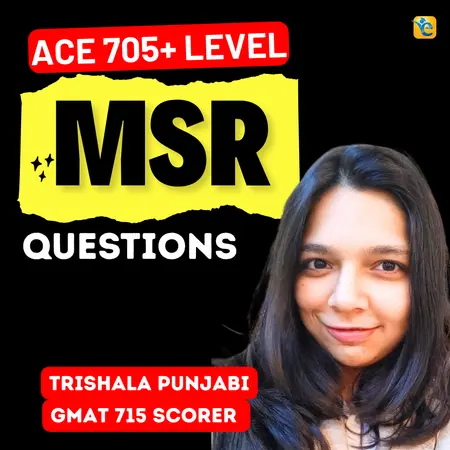Events & Promotions
|
|

GMAT Club Daily Prep
Thank you for using the timer - this advanced tool can estimate your performance and suggest more practice questions. We have subscribed you to Daily Prep Questions via email.
Customized
for You
Track
Your Progress
Practice
Pays
Not interested in getting valuable practice questions and articles delivered to your email? No problem, unsubscribe here.
- Nov 18
11:00 AM PST
-12:00 PM PST
Join us in a live GMAT practice session and solve 30 challenging GMAT questions with other test takers in timed conditions, covering GMAT Quant, Data Sufficiency, Data Insights, Reading Comprehension, and Critical Reasoning questions. - Nov 22
11:00 AM IST
-01:00 PM IST
Do RC/MSR passages scare you? e-GMAT is conducting a masterclass to help you learn – Learn effective reading strategies Tackle difficult RC & MSR with confidence Excel in timed test environment - Nov 23
11:00 AM IST
-01:00 PM IST
Attend this free GMAT Algebra Webinar and learn how to master the most challenging Inequalities and Absolute Value problems with ease. - Nov 25
10:00 AM EST
-11:00 AM EST
Prefer video-based learning? The Target Test Prep OnDemand course is a one-of-a-kind video masterclass featuring 400 hours of lecture-style teaching by Scott Woodbury-Stewart, founder of Target Test Prep and one of the most accomplished GMAT instructors.
Kudos
Bookmarks
Verbal Experts’ Topic of the Week, June 26-30, 2017
WTF is “that” doing in my sentence?
Let’s start with yet another pop quiz, because we’re still cruel like that.
Except that this one is pretty easy. Here’s the question: is the following sentence acceptable on the GMAT?
- Bogdan's favorite restaurant is in Brooklyn that serves delicious Ukrainian vareniki.
Easy, right? Unless you’re brand-new to the GMAT, you’ve probably learned that “that” must modify the immediately preceding noun. So the sentence is illogical, since it’s literally saying that Brooklyn serves delicious Ukrainian vareniki – not the restaurant.
Easy enough. So how about this one?
- Although nearly everybody agrees that Carmelo Anthony is a terrible fit for the modern NBA, he nevertheless earns more than $30 million per year.
If you’re blindly following the “rule” that the word “that” must always modify the immediately preceding noun, you might hastily conclude that this sentence is incorrect, because “that” follows the verb (“agrees”). But this sentence is completely fine, and that brings us to an oddly nuanced question: what are the different uses of “that” on the GMAT?
So in the spirit of our previous posts on “-ing” and “-ed” words, here’s a guide to the GMAT’s four main uses of “that”.
Usage #1: "that” as a pronoun
I hear plenty of worries on GMAT Club about the use of “that” as a modifier, but in many cases, “that” is actually a noun. Here are a couple of examples:
- Like the poetry of Bruce Willis, that of Chuck Norris is flowery and pretty.
- Some have compared Russell Westbrook’s fashion sense to that of Kim Kardashian.
Whenever “that” is used as this type of pronoun (called a “demonstrative pronoun”, if you like jargon), it’s always singular. It’s just a tiny bit different from “it”, though: “that” basically creates a “copy” of the noun it refers back to.
So here’s what you always want to do when you see “that” used as a pronoun: replace “that” with the singular noun it “copies”, and then see if it actually makes logical sense. In my silly examples above, here’s what you’d have:
- Like the poetry of Bruce Willis, the poetry of Chuck Norris is flowery and pretty.
- Some have compared Russell Westbrook’s fashion sense to the fashion sense of Kim Kardashian.
Both of these make sense, so we’re all good. But the GMAT’s favorite trap with the pronoun “that” is to stick it in random places where it doesn’t belong. Check out this recent SC Question of the Day for a great example of “that” used (or misused, depending on the answer choice) as a pronoun. If you’re diligent about replacing “that” with the noun it “copies”, you won’t have any trouble at all.
Some of our other favorite official questions with demonstrative pronouns can be found here, here, and here. And this one is a particular favorite of mine, since it really forces you to think about what “that” is actually doing in the sentence.
On to the second use of “that” on the GMAT:
Usage #2: “that” as an article
The second use of “that” really isn’t all that interesting, and it rarely causes any trouble on the GMAT: “that” can just be an article that precedes a noun. A couple of examples:
- Mike read Lord of the Flies in high school; like most teenagers, he absolutely detested that book, and prefers literature by Tripathi and Hitler.
- Charlie is obsessed with Neerob, a Bengali eatery in the Bronx, because that restaurant’s shrimp dopeaja is consistently amazing.
In both examples, “that” is simply an article, and it’s not all that different from “the book” or “the restaurant”, except it refers back to a specific case mentioned earlier. Now, we’re not just talking about “a book” or “a restaurant” – we’re discussing that particular book or that particular restaurant.
And don’t worry: you’ll never have to choose between “that” and “the” on the GMAT. The GMAT isn’t going to do anything tricky with “that” as an article – you just don’t want to develop a case of tunnel vision, and mistake the article “that” for a noun or a modifier.
Need an official example? Here's a nice, harmless question, featuring the word “that” used as an article.
I know: that really wasn’t very exciting. Let's move on to usage #3:
Usage #3: subordinating clauses with “that”
Remember this sentence from the beginning of this thread?
- Although nearly everybody agrees that Carmelo Anthony is a terrible fit for the modern NBA, he nevertheless earns more than $30 million per year.
Occasionally, I’ll hear GMAT test-takers say that this example is wrong, because “that” must modify a noun, not a verb. But in this example, “that” is just the beginning of a subordinate clause: what is it that everybody agrees on? That “Carmelo Anthony is a terrible fit for the modern NBA.” A good example of this type of usage on the GMAT can be found in this Question of the Day, which also features some nice parallelism issues.
Again, this particular use of “that” is unlikely to cause trouble for you on the GMAT, unless you develop yet another terrible case of tunnel vision, and decide that “that” can only modify nouns.
And now for the fun stuff:
Usage #4: "that" as a modifier (the “touch rule" and its exceptions)
As we mentioned at the beginning of the article, one of the first things most people learn about GMAT sentence correction is the so-called “touch rule”: noun modifiers beginning with “that” (or “which” or “who” or “when” or “where” or “whose”) must always “touch” the noun being modified. Back to our silly example from earlier:
- Bogdan's favorite restaurant is in Brooklyn that serves delicious Ukrainian vareniki.
You’re probably still not fooled by this one: it’s literally saying that Brooklyn serves Ukrainian vareniki, and that’s simply not logical.
OK, so how about this one?
- The son of a gun that burned my dinner deserves to be punished.
If you’re being too hasty with this, you might say, “Wait, the gun didn't burn my dinner – the son did. So it’s wrong!” (For those of you who aren’t familiar with obsolete American slang: “son of a gun” is basically a really silly, mid-20th century synonym for “jerk.”)
But the sentence isn’t wrong at all, because this is a perfectly acceptable exception to the “touch rule.” The noun modifier “that burned by dinner” is “reaching back” to modify “the son” – not the gun – and that’s completely fine here. Why is that acceptable? The phrase “of a gun” is a prepositional phrase that also modifies “the son.” And it can be perfectly OK for a noun modifier to “reach behind” a prepositional phrase, as long as it’s necessary for the meaning of the sentence.
Here’s a less-slangy example:
- The first-class airline tickets to Antarctica that were purchased using Amber’s retirement savings were worth every penny.
Again, if you’re being too hasty, you might assume that the sentence is literally saying that “Antarctica were purchased using Amber’s retirement savings” – and that’s obviously incorrect. But notice that “to Antarctica” is another prepositional phrase, so it’s possible for “that were purchased” to “reach behind” the prepositional phrase if need be.
And in this case, that seems perfectly reasonable: the “first-class airline tickets… that were purchased…” makes sense. So this sentence is completely fine.
Please don’t hallucinate the exceptions!
Here’s the important thing to remember: in the vast majority of GMAT questions, “that” and other noun modifiers (“which”, “who”, “where”, “when”, etc.) will still “touch” the noun being modified. The exceptions exist, but they’re relatively rare.
So if you think you might have an exception to the “touch rule”, look for two major characteristics:
- 1) “that” (and similar noun modifiers) can generally only “reach behind” prepositional phrases -- not verbs or clauses (there are exceptions, but they're relatively rare)
2) the meaning of the sentence must give you a compelling reason to “reach behind” the prepositional phrase
So please keep in mind that exceptions to the “touch rule” are relatively rare – and that the word “that” might not even be a modifier at all.
If you want official examples of violations of the “touch rule”, check out some of our favorites here, here, or here.
Want more?
- Live Wednesday verbal chats! Ask your questions here.
- GMAT Club’s YouTube page, including a video of some tutor guy babbling about the GMAT’s many uses of “that”
- For more exciting GMAT modifier action, check out this Topic of the Week on ”-ing” words…
- …or this Topic of the Week on “-ed” words
- A nice article from e-GMAT on violations to the “touch rule”
- Here’s a complete collection of modifier threads by souvik101990
- An incredible master directory to official verbal questions, compiled by @carcass
- What to do about timing on GMAT verbal
- All verbal experts’ Topic of the Week threads, compiled by @carcass
Kudos
Bookmarks
Thanks a lot for this, I hope lots of our mistakes will be rectified with this understanding.
Sent from my SM-G610F using GMAT Club Forum mobile app
Sent from my SM-G610F using GMAT Club Forum mobile app
GMATNinja
Hi GMATNinja,
Sometimes that is not followed by complete verb and is used in comparison to specify an entity too.
Any views on this OG eg:
https://gmatclub.com/forum/scientists-h ... 05348.html
Here THAT is very much required since its absence distorts comparison.
When used as demonstrative pronoun, as in your post, it can not be followed by verb / clause.
However more usage in GMAT is of that as relative pronoun must be followed by verb, making THAT ... a dependent clause.
Is this usage correct?
WR,
Arpit












